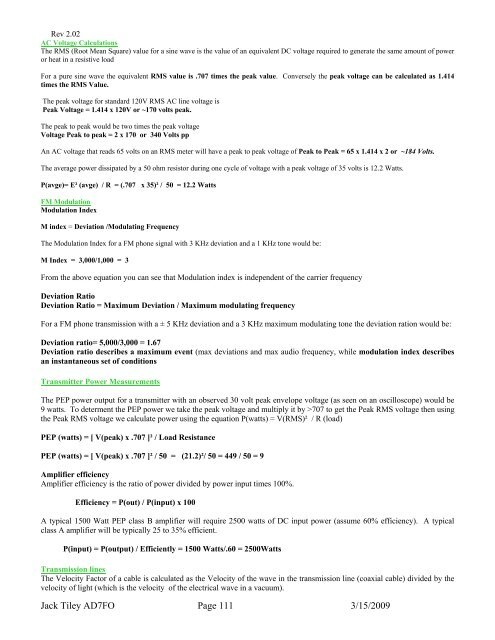You also want an ePaper? Increase the reach of your titles
YUMPU automatically turns print PDFs into web optimized ePapers that Google loves.
Rev 2.02<br />
AC Voltage Calculations<br />
The RMS (Root Mean Square) value for a sine wave is the value of an equivalent DC voltage required to generate the same amount of power<br />
or heat in a resistive load<br />
For a pure sine wave the equivalent RMS value is .707 times the peak value. Conversely the peak voltage can be calculated as 1.414<br />
times the RMS Value.<br />
The peak voltage for standard 120V RMS AC line voltage is<br />
Peak Voltage = 1.414 x 120V or ~170 volts peak.<br />
The peak to peak would be two times the peak voltage<br />
Voltage Peak to peak = 2 x 170 or 340 Volts pp<br />
An AC voltage that reads 65 volts on an RMS meter will have a peak to peak voltage of Peak to Peak = 65 x 1.414 x 2 or ~184 Volts.<br />
The average power dissipated by a 50 ohm resistor during one cycle of voltage with a peak voltage of 35 volts is 12.2 Watts.<br />
P(avge)= E² (avge) / R = (.707 x 35)² / 50 = 12.2 Watts<br />
FM Modulation<br />
Modulation Index<br />
M index = Deviation /Modulating Frequency<br />
The Modulation Index for a FM phone signal with 3 KHz deviation and a 1 KHz tone would be:<br />
M Index = 3,000/1,000 = 3<br />
From the above equation you can see that Modulation index is independent of the carrier frequency<br />
Deviation Ratio<br />
Deviation Ratio = Maximum Deviation / Maximum modulating frequency<br />
For a FM phone transmission with a ± 5 KHz deviation and a 3 KHz maximum modulating tone the deviation ration would be:<br />
Deviation ratio= 5,000/3,000 = 1.67<br />
Deviation ratio describes a maximum event (max deviations and max audio frequency, while modulation index describes<br />
an instantaneous set of conditions<br />
Transmitter Power Measurements<br />
The PEP power output for a transmitter with an observed 30 volt peak envelope voltage (as seen on an oscilloscope) would be<br />
9 watts. To determent the PEP power we take the peak voltage and multiply it by >707 to get the Peak RMS voltage then using<br />
the Peak RMS voltage we calculate power using the equation P(watts) = V(RMS)² / R (load)<br />
PEP (watts) = [ V(peak) x .707 ]² / Load Resistance<br />
PEP (watts) = [ V(peak) x .707 ]² / 50 = (21.2)²/ 50 = 449 / 50 = 9<br />
Amplifier efficiency<br />
Amplifier efficiency is the ratio of power divided by power input times 100%.<br />
Efficiency = P(out) / P(input) x 100<br />
A typical 1500 Watt PEP class B amplifier will require 2500 watts of DC input power (assume 60% efficiency). A typical<br />
class A amplifier will be typically 25 to 35% efficient.<br />
P(input) = P(output) / Efficiently = 1500 Watts/.60 = 2500Watts<br />
Transmission lines<br />
The Velocity Factor of a cable is calculated as the Velocity of the wave in the transmission line (coaxial cable) divided by the<br />
velocity of light (which is the velocity of the electrical wave in a vacuum).<br />
Jack Tiley <strong>AD7FO</strong> Page 111 3/15/2009


